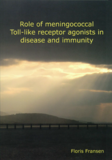Role of meningococcal Toll-like receptor agonists in disease and immunity

Fransen, Floris
- Promoter:
- Prof.dr J.P.M. (Jos) van Putten & prof.dr C.J.P. (Claire) Boog
- Co-promoter:
- Dr P. (Peter) van der Ley
- Research group:
- Putten
- Date:
- March 11, 2010
- Time:
- 16:15 h
Summary
Neisseria meningitidis is a Gram-negative bacterium that may cause the life-threatening diseases meningitis and sepsis in humans. Much of the symptoms seen in these diseases are not caused by the bacterium directly, but are the result of overstimulation of the immune system. Lipopolysaccharide (LPS), a major component of the bacterial outer membrane, is thought to play a major role in the pathology of these diseases, because it activates the immune system very potently. The Netherlands Vaccine Institute is currently developing a vaccine against N. meningitidis that consists of outer membrane vesicles (OMVs). This vaccine still contains LPS, which is not ideal due to its toxicity. On the other hand, by activating the immune system LPS improves the immune response after vaccination. Therefore, LPS is a good adjuvant. LPS initiates activation of the immune system by binding to its receptor Toll-like receptor (TLR) 4, which is expressed by numerous cell types of the host. Currently, several other TLRs have been identified and each TLR recognizes different structures derived from microbes. Activation of all TLRs eventually leads to activation of the immune system. This means that all TLRs are potential adjuvant targets. In addition, TLRs differ in the pathways that become activated after recognition of its ligand. As a consequence the type of immune response that is induced depends on which TLR is activated. The aim of the study described in this thesis was to investigate which TLR ligands are suitable adjuvants for a meningococcal vaccine and to understand their mode of action. In addition, we explored the impact of modulation of meningococcal structures recognized by TLR ligands on the host response after infection with N. meningitidis. We found that several TLRs are interesting adjuvant targets for a vaccine against meningococci. Besides TLR4, OMVs also activate TLR2. We show that in mice TLR4 activation is essential for optimal immune responses after immunization with OMVs, but that TLR2 activation is not required. In addition, we found that around 10% of patients with meningococcal disease are infected with an LPS-mutant that is hardly recognized by TLR4. Interestingly, patients infected with this mutant showed much less severe symptoms. Finally, we demonstrate that modulation of the LPS structure has a big impact on the virulence of N. meningitidis in a mouse model of meningococcal disease. Together our results illustrate the dominant role played by LPS in meningococcal disease and immunity. In addition, our results suggest that wild-type LPS in a meningococcal vaccine can be replaced by mutant LPS or TLR ligands that activate the immune system less potently, but still well enough for a good immune response after vaccination.